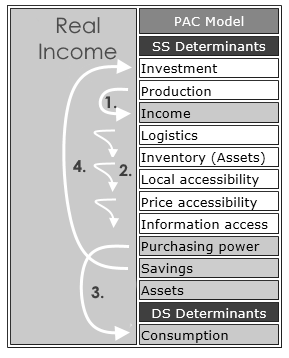A clarification of the role and significance of supply side operations
Hector McNeill1
SEEL
Please note: The original title of this article was: "A clarification of supply side economics". However, this has been changed so as to avoid any confusion with what is known as "supply side economics" which is a fiscal scheme with little connection to the operation of the production and services supply sectors. |
I was recently surprised by a public statement made by an economist who seemed to indicate he considered supply side and Say's law to be nonsense. His position is that our economies are "demand led". Economies are indeed "demand led" as a direct result of inappropriate policies which have entered a period of increasing decadence as a result of a transformation into being "debt led". This criticism of Say's theory is not correct and it would seem that even some so-called "alternative economists" take this same line.
As economists by training, many of us will have come across lecturers who referred to Say's Law as an oddity devoting no more than a few minutes to the topic. On the other hand, Lorie Tarshis, Head of the Department of Economics at the University of Stanford, was an odd one out. He went through Say's proposition explaining in some more detail why Say was likely to have been misunderstood by both Keynesians and Monetarists. This was intriguing because Tarshis was one of Keynes' students and most of his teaching was about Keynesian basics.
This article is an attempt to clarify why Say's position was not incorrect but rather, as Tarshis observed, is poorly understood. It can explain much of the ills that have beset us as a result of governments having imposed aggregate demand management policies for far too long.
|
The source of income giving rise to consumption

Jean Baptiste Say
1767-1832 |
|
|
Jean Baptiste Say was a French economist and businessman and corresponded with Robert Malthus; they agreed on much. Both Malthus and Say thought Adam Smith's contributions to economics to have been considerable. It is notable that all three were free trade advocates.
It is often stated that Say's law is that "Supply creates its own demand". I have not been able to find where Say expressed his position in such stark terms. However this short statement is easy to misunderstand.
In Say's writings, such as in his "A Treatise on Political Economy or The Production, Distribution and Consumption of Wealth", published in 1803 and in his correspondence with Malthus he was careful in his stepwise explanation of the logic of his position. It should not be overlooked that, unlike many economists, Say was also an industrialist employing at one time around 500 people. So it is necessary to take this into account before dismissing his analysis as nonsense.
I should add that the message is in the sub-title of his work "Production, Distribution and Consumption of Wealth". The attentive reader will no doubt have noticed that the The Production, Accessibility & Consumption Model

Note that the all of the Demand Side Determinants (DS Determinants) generating consumption, come from the Supply Side Determinants side (SS Determinants). |
|
|
real incomes approach is based on the "Production, Accessibility and Consumption Model".
In order to comprehend Say's position it is necessary to trace the movement of funds that give rise to consumption.
The money used by households to consume what they need and the funds used by companies to purchase capital goods and inputs comes from salaries, wages and revenues. This money flow is only received as a result of individuals having worked and companies having produced output. Only then are such funds paid. Who pays this money? The source of these monetary transfers is the production units who pay people and other companies for their supply of inputs. As can be appreciated the consumption levels depend upon the amounts paid by production units to people and companies who consume.Taking the sum total of production units, including those supplying imports, it is self-evident that one ends up with an equilibrium represented by incomes, less savings, being equal to total consumption.
Real incomes
Where producers improve their productivity through changes in technologies, techniques and reassignment of personnel and workers gain tacit knowledge and improve their competence in carrying out specific jobs, it is possible for more to be produced in physical terms making use of less physical inputs as a result of less waste and faster production. If producers, under such circumstances raise wages and also stabilize, or slightly, reduce unit prices, the growth in real incomes of the whole economy rises. Thus the same nominal incomes and revenues can purchase more real physical produce and services. In other words it is possible for consumption levels to rise as a result of increased real incomes while the nominal value of transactions remains the same. Where people are content with the basic basket of purchases they might save the additional income to accumulate funds to purchase some additional items, such as a house, automobile or perhaps, not save and simply spend the increased purchasing power on higher priced goods and services. This increase in consumption, as one can readily appreciate, does not come from some mythical injection of demand. It has arisen directly as a result of unit pricing and investment decisions of production units to enhance productivity and pay their work forces a better wage.
The most obvious example of this process has been the significant technology driven increases in productivity in the information technology and telecommunications industries manufacturing and services sectors. This has been associated with pricing decisions that have followed a downward trend which has resulted in people's real incomes or purchasing power, for such devices, increasing. So supply side management and decisions making have been the main driver of consumption and the funds used in that consumption have come from the production, or, supply side.
Is the economy demand led? - functional issues
The use of the term demand is so common that it leads to a distortion in the understanding of the evolution of supply side made up of companies, groups and individuals who produce goods and services. Much of what is consumed today was never imagined to be of utility or worth having simply because they did not exist for technological or the reason of not having been discovered. Many products such as bicycles, automobiles, trains and airplanes did not come into existence because of demand. They came into existence because innovative individuals imagined that there would be a benefit to society if such things could be developed. So a long process of development, trial and error and finalization of production made such products available. It is only a result of this constant refinement in explicit and tacit knowledge that this process of increasing diversity in products and services that new products and services appear, at which point consumption and take up begins and as a result of the demonstration effect and the exchange of information consumption becomes more generalized. The money used for consumption, as explained in this article, comes from incomes of companies and employees from the production units across all sectors. The management of the levels of consumption in different markets remains very much in the hands of producers as a result of changes in product quality, market segmentation and price setting. In this way consumption is managed. The money spent on consumption, unit prices and product qualities available are all established by the supply side decision making.
This is not quite the same as the economy being demand led.
Is the economy demand led? - policy issues
The fixation with the mantra that the economy and economic growth depends on demand is a specific interpretation of how economies work. This promoted by those who wish to impose the aggregate demand model (ADM). ADM is an economy command and control system that imposes centrally imposed interventions in markets by setting interest, money volumes as debt, government revenue seeking as levies and taxation shored up by accountancy regulations that make wage earners a cost while other employees earn bonuses and shareholders, dividends. At the same time policies are framed as supporting the "free market". Managing inflation, deflation, unemployment is imagined to be influenced by "demand" levels manipulated through infusions of debt and low interest rates or high interest rates which, in each case, generate winners, losers and some who remain in neutral policy-impact states. After four major financial crises and prejudice arising from this form of demand management, it is puzzling to come across some economists who are prepared to make public statements that, in spite of this level of the policy-induced chaos, that the economy policy is demand led. Demand from where exactly?
Concluding
Elsewhere on this site there is much to throw sufficient doubt on the efficacy of the out-of-date notion that economies are led by demand. Economies need to be moulded by the evolving capacity of the supply side which under truly free markets can carry our economies forwards without the instabilities associated with imposed "demand led growth". It is more than evident that after four major financial disasters, demand led policies have conveniently provided us with track records that demonstrate that the theory behind these policy frameworks is flawed. The price paid by society through the imposition of this social experimentation has been unnecessary prejudice and human suffering. I am not sure what else I can add here to do justice to Jean Baptiste Say's perceptive vision of the potential role of economics to mankind.
1 Hector McNeill is the Director of SEEL-Systems Engineering Economics Lab.
All content on this site is subject to Copyright
All copyright is held by © Hector Wetherell McNeill (1975-2020) unless otherwise indicated
|
|
|
|